Here’s Why You Need to Avoid Pre-Checked Opt-In Boxes
Growing lists is a great thing—as long as that growth is meaningful. Pre-checking opt-ins can set your marketing efforts up for failure. Here’s what to do instead.

Growing lists is a great thing—as long as that growth is meaningful. Pre-checking opt-ins can set your marketing efforts up for failure. Here’s what to do instead.

Some marketing tactics backfire. Aggressive retargeting ads that provide a call to action to contact a specific sales rep. Companies that make it impossible to cancel a service. Websites that expect you to navigate a minefield of pop-ups.
Oh, and pre-checked opt-in boxes.
Pre-checking an opt-in box is one of the few that can land your business in hot water. The European Union’s General Data Protection Regulation (GDPR) requires companies to ask explicit consent before hoovering up their data.
The same concept is also at the heart of Canada’s Anti-Spam Legislation and Section 1759.2 of the California Anti-Spam Law. And the Telephone Consumer Protection Act (TCPA) has required express written consent to text customers for many years.
There is no doubt these regulations have ushered in higher standards for marketing teams. Yet, there is still widespread confusion on what’s both legal and best practice when it comes to SMS marketing.
We answer all your burning questions on opt-in boxes when collecting phone numbers (and how to ensure your web forms are TCPA compliant).
We wrote an entire guide on text marketing compliance with a dedicated section just for express written consent.
Simply put, express written consent requires an affirmative action: your audience must provide a clear yes in response to whether they want to receive your texts or not. (Don’t worry, they don’t need to actually handwrite anything–it can be given electronically.)
On top of this, you must provide clear and conspicuous disclosure of what the user is consenting to, and who they’re permitting to get it from.
The impact of express written consent on web forms is straightforward: a pre-checked opt-in box is not an affirmative action and therefore doesn’t count as express written consent.
We’re not pedantic here either. Last year Hot Topic settled a Class Action lawsuit for $3 million brought by someone who asserted that by sending her a promotional text message, the company had run afoul of the TCPA law.
Hot Topic argued that the individual had failed to uncheck a pre-checked box indicating “Yes, I want to receive text messages about special events and offers,” and thus, expressly consented to the company contacting her.
It turns out that the judge didn’t agree and the company ended up settling the lawsuit outside of court.
Beyond the potential for jaw-dropping settlements, there are two other reasons that pre-ticked boxes are not best practice.
We’ve built the ability to create sign-up forms right into our platform. Adding one to your website is as easy as copying and pasting a small piece of code.
To ensure your advertisements are TCPA compliant, they must clearly and conspicuously disclose that a) the messages to be received will be marketing/promotional in nature, b) the messages will be sent via an autodialer and c) the agreement to receive the autodialed promotional text messages isn’t a condition of any purchase.
Additionally, in order to also comply with the CTIA’s guidelines, your advertisements must include your campaign purpose, message frequency, info about message and data rates, plus a link to your terms and conditions and privacy policy.
Here’s an example of a compliant sign-up form. You can learn more about creating one here.

If you don’t want to make any adjustments to your existing forms, there are other ways to collect phone numbers. For example, you can create an SMS keyword and promote it across your marketing channels.
A keyword is a short word or phrase that your audience can text to a phone number to sign up for your text messages.

Rather than fight the growing number of regulations that require express consent, it’s better to align your marketing with these best practices. By doing this, you’ll experience higher engagement and a closer relationship between your brand and subscribers.
Drew Wilkinson is the Head of Marketing at SimpleTexting. Drew has more than a decade of experience managing successful integrated marketing programs to build brands, raise awareness, and generate demand.
More Posts from Drew WilkinsonIt happens. Sometimes people unsubscribe from your messages. The good news is there's plenty you can do to make sure you keep as many contacts as possible.
ReadLooking for simple, ongoing methods to get more text marketing contacts? Look no further than these three opt-in strategies.
ReadStart a text marketing campaign or have a 1-on-1 conversation today. It's risk free. Sign up for a free 14-day trial today to see SimpleTexting in action.
No credit card required